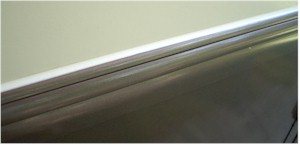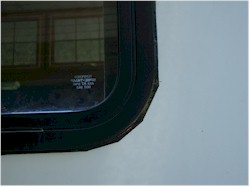|
Wolf's Motorhome Modifications ... and Other Stuff Sealing--DO IT NOW!
People with new motorhomes tell people who are looking at used motorhomes that delamination is an indicator that the motorhome should not be considered for purchase. Poppycock! Every motorhome on the road will, as it ages, suffer water incursion. As it does, that motorhome will suffer delamination. You can prove this to yourself. Take a walk through any used RV lot and look at RVs ten or years old. Every one will have delamination. The dopey fellow with the new motorhome will have delamination. The reason for this is that water gets you before you know you've been got. The delamination is most often your first warning that your motorhome has a leak. The solution is easy. Every five years reseal every seam. Every one! What NOT to Use Use the right product. Silicone sealants are not the right product. Unless you get a highly specialized form of silicone, it will contain talc. The talc will absorb water. The silicone will fail. Don't use that heavy asphaltic white roof coating that is sometimes used on old mobile homes. Old mobile home roofs were made with sheets that were seamed every four feet or so. The white stuff sucks as a sealant. It sucks as a coating as it is so very heavy. Don't use either product! Use a one-part polyurethane sealant/adhesive. Only use a product that is designed for marine use and designed for use under water. 3M makes a product called 5200 that is a sealant/adhesive. They aren't kidding about the adhesive part. Once this product cures, you will have a devil of a time getting the parts to separate. You must mechanically disrupt the bead and coat it with a remover to get it to give way. This isn't a problem with my seams. Not only do I not plan on breaking my seals, I don't want them falling apart. I use 5200 on all my seams. 3M also makes a 4200 sealant/adhesive that is made for parts that must later be separated. Both varieties come in black and white (and perhaps a brown). They come in fast cure and slow cure varieties. Fast cure is set in 24 hours. The regular stuff takes three days. They aren't kidding. While it will skim over in a day, it will take days, even a week, to fully cure. This means the sealing must be timed for nice weather. I use the regular cure stuff as I don't want incursion. I want the seal to be as tough as I can get it to be. I use black for the darker parts of my box and white for the lighter. I don't mess with brown. I use masking tape on the windows. For the rest of the box I made a bead with my finger. It isn't that pretty. It isn't that neat. It is messy as all get out. The black stuff gets all over everything. Clean up areas on the motorhome with some alcohol. That works until the seam is cured. After that removing it ... well ... you don't want to know. I carefully seal everything but the air conditioners on the roof by either beading over the existing bead or smearing new sealant over old. Note, Winnebago used an excellent sealer to start with. All I am doing is shoring up what has been on the box for a number of years. If your brand has bad sealant, you need to remove it. Better yet, buy a better motorhome. |


